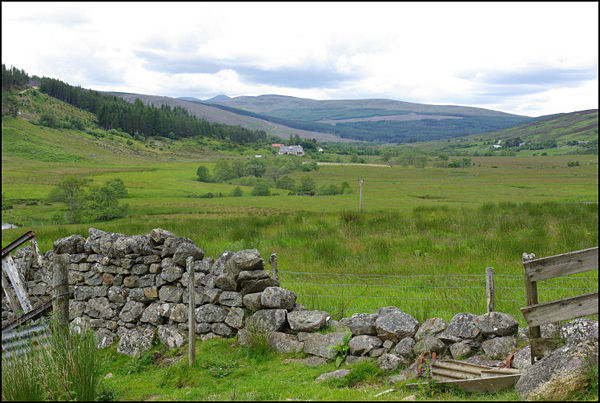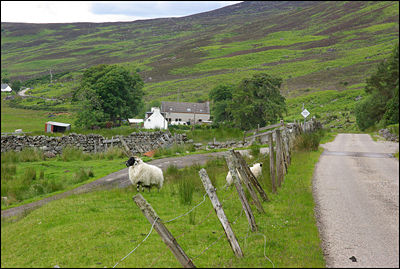
Strathrusdale
Encyclopedia
Strathrusdale Glen
in the Highlands
of Scotland
forming the western part of the area known as Ardross
. The Glen runs east to west for 2.5 miles and the river Blackwater flows through it to merge at the eastern end with another tributary to form the River Alness. The valley floor is mainly fields used for sheep grazing. The glen is surrounded by commercial pine forest, except to the north, which is dominated by the mountain Beinn Tharsuinn (2831ft). Traditionally the glen was populated by tenant crofters, however in recent years there has been an increase in the number of new homes and restorations, after many decades of gradual decline.
 Strathrusdale looking west
Strathrusdale looking west
. Picts
lived in the area until the 10th century, which was part of the Kingdom of Fortriu. After this period there was progressively more transition as Norse settlement began to increase in the area.
During the late 18th century, great change swept the Highlands when landowners realised that more income could be generated by clearing areas farmed by tenant crofters to make way for sheep. Termed the Highland Clearances
, this coincided with a period of great unrest and social upheaval in Europe which unsettled the authorities in Britain.
Strathrusdale became the focus of the clearance policy in 1792 when on the 27th of July the inhabitants of the glen gathered for a wedding in the area where a plot was devised to drive away all the sheep, and by implication all the sheep-farmers. A week later about 400 men from the surrounding districts were driving six thousand sheep towards Beauly
.
 The sheriff-depute of the county, Donald MacLeod, wrote to the Lord Advocate, asking that a force of the Black Watch
The sheriff-depute of the county, Donald MacLeod, wrote to the Lord Advocate, asking that a force of the Black Watch
be sent north to defeat what MacLeod viewed as open rebellion. The Lord Advocate wrote to the Home Secretary Henry Dundas
reporting that sheep farming was very unpopular in the Highlands, as it ‘tended to remove the inhabitants from their small possessions and dwelling houses’. The Home Secretary replied that it was ‘undisputably necessary that the most vigorous and effectual measures should be taken for bringing these daring offenders to punishment’ - and ordered troops north. After a midnight attack on Saturday 6 August by the troops of the Black Watch, the drovers scattered and returned to their crofts.
In September, the eight ringleaders of the drive appeared in court at Inverness
, charged with ‘advising, exciting, and instigating persons riotously and feloniously to invade, seize upon, and drive away from the grounds of the proprietors flocks of sheep’ and placing the owners ‘at the mercy of a lawless and seditious mob’. Among them were John Ross, a tenant in Strathrusdale, along with his sons Alexander and John Ross, and Donald Munro alias MacAdie and his son William MacAdie. They were all found guilty, two were sentenced to transportation to Botany Bay, while other sentences included life imprisonment, banishment and various terms in gaol. Subsequently, all the prisoners escaped from their captors and disappeared for good despite a £5 reward for each of them.
Glen
A glen is a valley, typically one that is long, deep, and often glacially U-shaped; or one with a watercourse running through such a valley. Whittow defines it as a "Scottish term for a deep valley in the Highlands" that is "narrower than a strath."...
in the Highlands
Scottish Highlands
The Highlands is an historic region of Scotland. The area is sometimes referred to as the "Scottish Highlands". It was culturally distinguishable from the Lowlands from the later Middle Ages into the modern period, when Lowland Scots replaced Scottish Gaelic throughout most of the Lowlands...
of Scotland
Scotland
Scotland is a country that is part of the United Kingdom. Occupying the northern third of the island of Great Britain, it shares a border with England to the south and is bounded by the North Sea to the east, the Atlantic Ocean to the north and west, and the North Channel and Irish Sea to the...
forming the western part of the area known as Ardross
Ardross, Highland
Ardross Rural area in the Highland region of Scotland, north of the nearest city, Inverness...
. The Glen runs east to west for 2.5 miles and the river Blackwater flows through it to merge at the eastern end with another tributary to form the River Alness. The valley floor is mainly fields used for sheep grazing. The glen is surrounded by commercial pine forest, except to the north, which is dominated by the mountain Beinn Tharsuinn (2831ft). Traditionally the glen was populated by tenant crofters, however in recent years there has been an increase in the number of new homes and restorations, after many decades of gradual decline.

History
Earliest evidence of habitation are still visible in Strathrusdale at the eastern end of the Glen, where there are a number of stone circles, which formed the base of Pictish roundhousesRoundhouse (dwelling)
The roundhouse is a type of house with a circular plan, originally built in western Europe before the Roman occupation using walls made either of stone or of wooden posts joined by wattle-and-daub panels and a conical thatched roof. Roundhouses ranged in size from less than 5m in diameter to over 15m...
. Picts
Picts
The Picts were a group of Late Iron Age and Early Mediaeval people living in what is now eastern and northern Scotland. There is an association with the distribution of brochs, place names beginning 'Pit-', for instance Pitlochry, and Pictish stones. They are recorded from before the Roman conquest...
lived in the area until the 10th century, which was part of the Kingdom of Fortriu. After this period there was progressively more transition as Norse settlement began to increase in the area.
During the late 18th century, great change swept the Highlands when landowners realised that more income could be generated by clearing areas farmed by tenant crofters to make way for sheep. Termed the Highland Clearances
Highland Clearances
The Highland Clearances were forced displacements of the population of the Scottish Highlands during the 18th and 19th centuries. They led to mass emigration to the sea coast, the Scottish Lowlands, and the North American colonies...
, this coincided with a period of great unrest and social upheaval in Europe which unsettled the authorities in Britain.
Strathrusdale became the focus of the clearance policy in 1792 when on the 27th of July the inhabitants of the glen gathered for a wedding in the area where a plot was devised to drive away all the sheep, and by implication all the sheep-farmers. A week later about 400 men from the surrounding districts were driving six thousand sheep towards Beauly
Beauly
Beauly is a town of the Scottish county of Inverness-shire, on the River Beauly, 10 miles west of Inverness by the Far North railway line. Its population was 855 in 1901...
.

Black Watch
The Black Watch, 3rd Battalion, Royal Regiment of Scotland is an infantry battalion of the Royal Regiment of Scotland. The unit's traditional colours were retired in 2011 in a ceremony led by Queen Elizabeth II....
be sent north to defeat what MacLeod viewed as open rebellion. The Lord Advocate wrote to the Home Secretary Henry Dundas
Henry Dundas, 1st Viscount Melville
Henry Dundas, 1st Viscount Melville PC and Baron Dunira was a Scottish lawyer and politician. He was the first Secretary of State for War and the last person to be impeached in the United Kingdom....
reporting that sheep farming was very unpopular in the Highlands, as it ‘tended to remove the inhabitants from their small possessions and dwelling houses’. The Home Secretary replied that it was ‘undisputably necessary that the most vigorous and effectual measures should be taken for bringing these daring offenders to punishment’ - and ordered troops north. After a midnight attack on Saturday 6 August by the troops of the Black Watch, the drovers scattered and returned to their crofts.
In September, the eight ringleaders of the drive appeared in court at Inverness
Inverness
Inverness is a city in the Scottish Highlands. It is the administrative centre for the Highland council area, and is regarded as the capital of the Highlands of Scotland...
, charged with ‘advising, exciting, and instigating persons riotously and feloniously to invade, seize upon, and drive away from the grounds of the proprietors flocks of sheep’ and placing the owners ‘at the mercy of a lawless and seditious mob’. Among them were John Ross, a tenant in Strathrusdale, along with his sons Alexander and John Ross, and Donald Munro alias MacAdie and his son William MacAdie. They were all found guilty, two were sentenced to transportation to Botany Bay, while other sentences included life imprisonment, banishment and various terms in gaol. Subsequently, all the prisoners escaped from their captors and disappeared for good despite a £5 reward for each of them.

